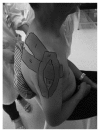The Effect of Kinesiology Taping on the Hemiplegic Shoulder Pain: A Randomized Controlled Trial
- PMID: 30651946
- PMCID: PMC6311752
- DOI: 10.1155/2018/8346432
The Effect of Kinesiology Taping on the Hemiplegic Shoulder Pain: A Randomized Controlled Trial
Abstract
Objective: The purpose of the study was to explore the effect of kinesiology taping on hemiplegic shoulder pain (HSP) in terms of pain intensity, magnitude of subluxation, muscle activity, and active range of motion (AROM).
Design: Double-blind, placebo-controlled clinical trial.
Setting: the Rehabilitation Center of the West China Hospital.
Participants: Nineteen individuals suffering from HSP were recruited in this study.
Intervention: Patients were randomly assigned into the taping group or control group. The taping group received therapeutic kinesiology taping and conventional treatment, while the control group received placebo taping (applied without tension) and conventional treatment.
Main outcome measures: The shoulder pain intensity (numerical pain rating scale), magnitude of subluxation, muscle activity (measured by surface electromyography (sEMG)), and shoulder active range of movement (AROM) were assessed at the baseline, on the first day (immediately after taping) and 4 weeks after treatment (without taping).
Results: All patients completed the trials. There were no significant differences between groups at the baseline. The taping group showed immediate improvement on the first day after taping in terms of pain intensity, magnitude of subluxation, and muscle activity (p < 0.05), whereas no significant changes seen in the control group (p > 0.05). After 4 weeks of treatment, the taping group showed significant changes in pain intensity, magnitude of subluxation, muscle activity, and AROM (p < 0.05). And significant differences in pain intensity and muscle activity could be seen between the two groups (p < 0.05).
Conclusion: The results indicate that the kinesiology taping is effective in reducing the shoulder pain and subluxation and increasing muscle activity and AROM for patients with HSP after stroke.
Figures
References
-
- Suethanapornkul S., Kuptniratsaikul P. S., Kuptniratsaikul V., Uthensut P., Dajpratha P., Wongwisethkarn J. Post stroke shoulder subluxation and shoulder pain: a cohort multicenter study. Journal of the Medical Association of Thailand. 2008;91(12):1885–1892. - PubMed
-
- Van Ouwenaller C., Laplace P. M., Chantraine A. Painful shoulder in hemiplegia. Archives of Physical Medicine and Rehabilitation. 1986;67(1):23–26. - PubMed
Publication types
MeSH terms
LinkOut - more resources
Full Text Sources
Medical


